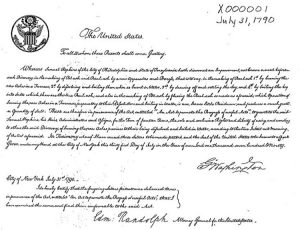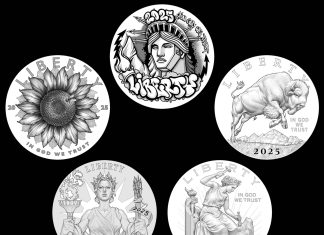 The United States Mint will soon produce and sell $1 collector coins in recognition of American innovation and significant innovation and pioneering efforts of individuals or groups from each of the 50 States, the District of Columbia, and the five U.S. territories.
The United States Mint will soon produce and sell $1 collector coins in recognition of American innovation and significant innovation and pioneering efforts of individuals or groups from each of the 50 States, the District of Columbia, and the five U.S. territories.
Coins for the 14-year program will be issued at a rate of four per year, beginning in 2019, for a total of 56 unique designs. The U.S. Mint has an option to increase the series to 57 coins by introducing the program this year.
The new series is authorized under the American Innovation $1 Coin Act. The legislation, H.R. 770, was introduced on Jan. 31, 2017. An updated version passed the House on Jan. 16 and the Senate agreed to an amended version on June 20. The House agreed with the final changes on June 27 and President Trump signed the bill into law (Public Law No: 115-197) on July 20.
Innovation/Innovator Selection and Order of $1 Issuance
The Secretary of the Treasury will select each innovation, innovator or pioneer, or group of innovators or pioneers after consulting the Governor or other chief executive of each state, the District of Columbia, or territory.
The dollars will be issued by order of a state’s entry into the Union followed by the District of Columbia, the Commonwealth of Puerto Rico, Guam, American Samoa, the United States Virgin Islands, and the Commonwealth of the Northern Mariana Islands.
Coin Designs
All coins from the program will share a common obverse depicting the Statue of Liberty, plus inscriptions of ‘$1’ and ‘In God We Trust’.
Coin edges will be incused with their year of minting or issuance, a mint mark denoting their production origin, and the inscription ‘E Pluribus Unum’.
Every reverse will be unique and emblematic of:
- A significant innovation,
- An innovator or pioneer, or
- A group of innovators or pioneers.
The Act prohibits the use of any portrait or bust of any person living or dead.
Reverses will also include inscriptions of the ‘United States of America’ and the location of the innovation/innovator — one of the 50 states, the District of Columbia, or U.S. territory.
The Secretary will select the eventual designs after consulting with the heads of the sites, the Commission of Fine Arts (CFA) and the Citizens Coinage Advisory Committee (CCAC).
2018 American Innovation $1 Coin

The U.S. Mint plans on striking an initial 2018 $1 coin to introduce the series. Its reverse must bear inscriptions of ‘United States of America’, ‘American Innovators’ and a representation of the signature of President George Washington on the first U.S. patent, No. X000001. This patent was issued on July 31, 1790, to Samuel Hopkins for an improvement in the making of pot ash and pearl ash.
The CCAC is scheduled to review and discuss candidate designs for the 2018 dollar on July 31, 2018.
Issued Alongside Native American Dollars
Innovation dollars follow the program of Presidential $1 Coins which ended in 2016. They will be minted alongside dollars honoring Native American tribes and individuals.
Dollar coins have not been released into circulation since 2011. The United States Mint produces them in circulating, proof and uncirculated finishes solely for coin collector products.






I can not beleive that this bill passed!! The politicians couldn’t wait very long to start a new useless dollar coin program. The Presidential dollars just finished in 2016. Why does the date and mint mark have to go on the edge? I can not think of another nation in the world that puts dates and mint marks on coin edge. Back in the 1700’s the U.S. put values on the edge of coins, but not dates. I think I’ll put my money into some great older U.S. coins that are a better investment. I hope more collectors will join… Read more »
“Useless dollar coins”? They are quite the collector’s items and very popular. Otherwise, the U.S. Mint would…stop making them. Take satisfaction in the fact that you have the option to buy them…or not buy them. And, it gives work to the people who work at the Mint, just as new orders give work to you at your place of employment.
I don’t think so – they have TOO many presidential coins fro 2097-2011 “left over”
I guess Sec. Munchkin can keep the unsed $1 in his Mansion & tip the unwashed masses who fight for a minimum wage……what a waste, does the USM input anything to Congress, what is this the only bill the GOP passed since tax giveaway???
US should stop printing a dollar bill . Made a new gold color dollar coin N gold $1000 coin (contain Mircochip technology) for circulation use! Make sure the coin can shining forever! Save the Earth . Stop use paper !
Oh really. Dollar bills are actually made of mostly cotton, not paper. So your comment should be considered as from uneducated person, not as a knowledgeable scientist who knows that dollar bills aren’t paper…
I would like the mint to be successful in this endeavor and I also want the collectors to like them. My suggestion would be to follow the British. They have the Queen’s Beast series which are 2 ounce coins, but the mint could make them either 2 or 3 ounces and in .999 silver. I believe they would have winners and the mint could make money doing this.
Just what we need, another multiple design program for a coin the public doesn’t use so, when encountered because a few of these coins will make it into circulation despite all attempts by the Mint to prevent it, it makes average non-collector consumer question if they’ve been given real money or not.
Try spending $2 bills with people unlikely to have ever seen one and their design has been the same for forty years.
If Americans weren”t so stubborn and refuse to be the slightest inconvenienced we could dump the paper dollar and go to a coin which would be less costly. Great Britian, Canada, and the EU have done it no one broke their backs carrying a few more coins around.